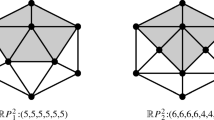Abstract
In this paper we study a natural generalization of Platonic solids: two-dimensional simply connected polygonal complexes with flag transitive group of combinatorial automorphisms. Our results give an almost complete description of such symmetric complexes with constant valency 3. The initial local data for the construction of such a complex are a regular k-gon and a (highly symmetric) graph L: the link at a vertex. We assume nonpositive curvature for the complex. This greatly simplifies the question of existence and the real issue is the uniqueness. The main ingredient of our analysis is the theory of regular graphs, a well-developed subject with 50 years of history. Delicate symmetry properties of these graphs yield a variety of local phenomena in complexes and provide the appropriate tool to study the uniqueness question. We should point out that many examples of the complexes we consider have already appeared in the literature, most prominently two-dimensional Bruhat—Tits buildings, but there have also been more recent constructions. We show that many of the symmetric complexes have nondiscrete automorphism groups. Clearly buildings are in this class, and some other examples were previously constructed. These automorphism groups resemble p-adic Lie groups and their further study should be worthwhile.
Similar content being viewed by others
References
Ballmann, W. and Brin, M.: Polygonal complexes and combinatorial group theory, Geom. Dedicata 50 (1994), 165–191.
Benakli, N.: Polyèdre à géométrie locale donnée, C.R. Acad. Sci. Paris 313, Serie I (1991), 561– 564.
Benakli, N.: Polyèdre hyperbolique à groupe d'automorphismes non discret, C.R. Acad. Sci. Paris 313, Serie I (1991), 667–669.
Biggs, N. L.: Constructing 5arctransitive cubic graphs, J. London Math. Soc. 26 (1982), 193– 200.
Bouwer, I. Z. (ed.): The Foster Census, Winnipeg, 1988.
Conder, M. and Lorimer, P.: Automorphism groups of symmetric graphs of valency 3, J. Combin. Theory B47 (1989), 60–72.
Coxeter, H. S. M.: Self-dual configurations and regular graphs, Bull. Amer. Math. Soc. 56 (1950), 413–455.
Djokovič, D. and Miller, G.: Regular groups of automorphisms of cubic graphs, J. Combin. Theory B29 (1980), 195–230.
Frucht, R.: A one-regular graph of degree 3, Canad. J. Math. 4 (1952), 240–247.
Gromov, M.: Hyperbolic groups, in S. Gersten (ed.), Essays in Group Theory, Springer Verlag, New York, 1987, pp. 75–263.
Haefliger, A.: Complexes of groups and orbihedra, in E. Ghys, A. Haefliger and A. Verjovsky (eds), Group Theory from a Geometrical Viewpoint (Trieste, 1990), World Scientific, 1991, pp. 504–540.
Haglund, F.: Les polyèdres de Gromov, C.R. Acad. Sci. Paris 313, Serie I (1991), 603–606.
Ronan, M.: Lectures on Buildings, Academic Press, Boston, 1989.
Tits, J.: Spheres of radius 2 in triangle buildings, in W. Kantor, R. Liebler, S. Payne and E. Shult (eds), Finite Geometries, Building and Related Topics (Pingree Park, 1988), Clarendon Press, Oxford, 1990, pp. 17–28.
Tutte, W. T.: A family of cubical graphs, Proc. Cambridge Philos. Soc. 43 (1947), 459–474.
Author information
Authors and Affiliations
Rights and permissions
About this article
Cite this article
Świa¸tkowski, J. Trivalent Polygonal Complexes of Nonpositive Curvature and Platonic Symmetry. Geometriae Dedicata 70, 87–110 (1998). https://doi.org/10.1023/A:1004954009167
Issue Date:
DOI: https://doi.org/10.1023/A:1004954009167



